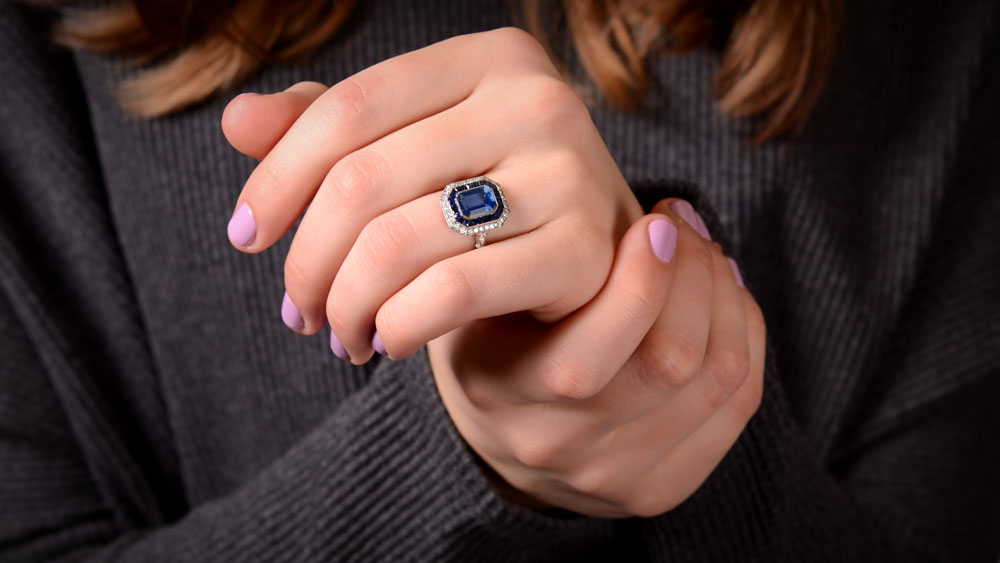[ad_1]
Kashmir Sapphires are one of the rarest gems in the world. Wearing it emits an upper-class aura. It’s a symbol of nobility and royalty. However, there is a lot to learn about this elusive sapphire.
We’ve been collecting Kashmir Sapphires for over 40 years, and so, using our knowledge, we’ve compiled a guide that will help you with everything that you need to know before you start your own collection.
History of Kashmir Sapphires

The history of Kashmir sapphires all started in 1880 in the Kashmir region on the Indian subcontinent. A landslide atop the Himalayas revealed an unusual type of rocks under the usual layer of soil. These rocks were almost completely bare except for the occasional protruding blue stones.
It took the locals a good period of time to realize that the stones were
actually sapphire. This caught the eye of the Maharajah (a regional ruler in India),
who sent a regiment of guards to protect the mine, along with miners to dig out
more of the sapphires.
The miners had to work in extreme conditions in the regional hot summer with little to no rest.
By the end of 1887, the famous Kashmir Mine was exhausted. Hungry for more, the Maharajah sought the assistance of the British, who by then had ruled in India for more than a decade. And with the help of British geologists, they found a new mine in the valley below.
However, they quickly exhausted the other mine too. To this day, no other Kashmir deposits have been found.
Timeline of Kashmir History
The timeline of the events that led to the discovery and depletion of Kashmir Sapphires is fascinating. Here is, in bullet-point form, the most notable events.
- 1880. Discovery of the main Kashmir Mine.
- 1882. The largest Kashmir Mining discoveries. Most Kashmir Gemstones available today were mined during these five years.
- 1887. Depletion of Kashmir Mine.
- 1906. C.M.P. Wright and the Kashmir Mineral Co. leases the mines and digs in a new location (without realizing that he discovered the New Kashmir Mines). He eventually gives up due to difficulties with digging conditions.
- 1927. Last recorded small discovery of any Kashmir Sapphires from new mines.
What Makes Kashmir Sapphires so Expensive?

The value of Kashmir sapphires is increasing every day. In fact, it is currently one of the strongest investment pieces of jewelry on the market.
Recently, Christie’s Auction House sold a 35.09-carat Kashmir blue sapphire for $7,357,999. For context, that’s $209,689 per carat. That’s the current world record. Expect it to go up in the following years.
- Rarity. The Kashmir Sapphire is the rarest type of sapphire on the market.
- Quality. The Kashmir Sapphire commands a high price because they contain a top-quality specimen. You may come across other blue sapphires, but only those from Kashmir have what experts call blue velvet – a dreamy cornflower blue that reflects light under all angles. See below.
- Prestige. The reputation of Kashmir Sapphires has taken on a life of its own. Some of the most important pieces of jewelry in the world showcase the Kashmir Sapphire in the center.
On top of its texture and tint, the outsized demand has just increased the price further.
All in all, Kashmir sapphires represent the crown of all sapphire gems.
Mounting this gem on a ring, necklace, or earring will enchant you with an
imposing, yet mysterious aura.
Guide to Shopping for the Perfect Kashmir Sapphire

As already mentioned, you should always consult with a Kashmir expert before buying a Kashmir sapphire. Just one carat of this magical gem can cost north of $200,000. Thus, you need to be sure of what you’re buying.
In some cases, the sellers may try to pass off other blue sapphires as Kashmir. Ceylon sapphires can come close, but there’s a huge gap in price between them. If you’re buying from an unknown seller, it’s far more likely that you’ll get offered a lesser-quality sapphire at Kashmir prices.
To avoid these situations, you should pay attention to these key factors.
But first, and we can’t restate this enough, only buy Kashmir Stones from reputable sellers. Jewelry this valuable requires a lot of good faith. Only purchase your sapphire from a company that has a track record (and reputation) of trust.
Proving Origin for Kashmir Sapphires

Proving origin is one of the most important parts of buying and selling a Kashmir Sapphire. Genuine Kashmir sapphires come from the mines of Kashmir at the Zanskar mountain range of the Himalayas. Almost all the value of the stone will be wrapped up in its proof of origin. In order to hold your investment, you will want to prove that the sapphire came from the Kashmir Mines.
The good news is that there are laboratories that can determine the origin of stones. They will examine the sapphire carefully and they will provide a document guaranteeing its status.
The top companies that provide reputable certificates for origin are:
- AGL – American Gemological Labs. The AGL certificates are considered to be the strongest Kashmir certificates in the industry.
- SSEF – Swiss Gemological Institute. A very authoritative choice for Kashmir origin.
- Gubelin – Gübelin Gem Lab. Another authoritative choice for Kashmir origin.
- Christian Duneg. He doesn’t have a website, but he is one of the top authorities on sapphires.
- GIA – Gemological Institute of America. The GIA isn’t recommended. See below.
- AGTA – American Gem Trade Association. The AGTA isn’t recommended. See below.
If you’re looking to buy a genuine Kashmir sapphire, you need a confirmation of the origin. And not just any confirmation either, you’ll want an official certificate of a reputable source confirming that it came from the Himalayan valley.
In the 1980s, there were many problematic certificates that confused the origins between Kashmir and Madagascar. As a result, we strongly recommend not using AGTA and GIA to determine origin. AGL, SSEF, Gubelin, and Christian Duneg are the highest authorities when determining origin.
Desired Color and Saturation

The strongest distinguishing feature of sapphire is its blueness. Obviously, the stronger the blue, the more valuable the stone. Kashmir Sapphires are no exception to this rule. You can encounter pale or intense blue sapphires, but they don’t hold the highest value.
Gemologists regard the azure blue sapphire as the rarest and most valuable. It contains a bright, pure tint of blue and a velvety texture. It’s the purest and the most prized of all Kashmir sapphires.
The royal blue Kashmir sapphire and the cornflower blue comes close. They’re a darker variant, but still highly sought-after.
That’s why the saturation plays a huge role in determining the value.
The least expensive Kashmir sapphires have subpar saturation such that they appear pale. Royal blue comes from strong saturation. However, the most desirable is the moderate to strong saturation that makes azure blue.
Additionally, you should always focus on the purity of
the stone. There shouldn’t be overtones of any other color, especially purple
and violet. Genuine Kashmir sapphires have an even blue color from top to bottom.
Clarity Range of Kashmir Sapphires

One of the most famous quality to Kashmir sapphires are it’s silk-like rutile needles. These titanium oxides (TiO2) internal needles reduce the gem’s transparency, but in return present a beautiful velvety shine that’s exclusive to Kashmir sapphires
These inclusions also allow light to travel evenly throughout the gem. If you shine a light into the gem, it’s indicative of a genuine Kashmir sapphire if it lights up all sides.
These thin inclusions are a great indicator of authenticity. If you don’t find these tiny needles (also known as internal silk) all over the core of the gem, it may be a good cause to raise your suspicion about the origin of the stone.
Cuts and Shapes of Kashmir Sapphires

There are two things to know when researching the cut of a sapphire:
- How Perfectly the Sapphire is Cut
- The Type of Shape
You’ll very rarely find a perfectly symmetrical cut of blue Kashmir, and there are a couple of reasons for that.
First, Kashmir Sapphires are old. They’ve been around for at least 100 years, and throughout that time, it’s almost impossible that they wouldn’t have a gotten a small bump here and there.
Secondly, the jewelers who would have cut the sapphire would have lived over 100 years ago. Stone-cutting technology has come a long way. In the early 1900s, the stone-cutting techniques were not too precise.
Additionally, Kashmirs would also require a great deal of patience and expertise to cut due to the tiny inclusions.
In regards to the shape, sapphires are usually cut to cushion, emerald, or oval-cut shapes. The less deep the stone, the better. Cutting the sapphire to be a little more shallow allows less light into the stone and keeps the stone with a deeper saturation.
But it’s actually the intact gems – those that aren’t cut at all – that are the most expensive. In fact, the aforementioned record-breaking stone was an uncut gem.
Therefore, you should know that a cut Kashmir sapphire usually sells for
a lower price. For example, if you want a heart-shaped blue Kashmir ring for
your wedding ring, you may get lucky and find one at a bargain price. However,
always look to buy from a trustworthy jeweler.
Price of Kashmir Sapphires

Now that you understand all the determining factors, let’s talk about
the price range of these gems. However, it can still be difficult to determine
a realistic price.
There isn’t a long trail of established prices for Kashmir sapphires due
to their rarity. Most stones are already in the hands of collectors, investors,
and jewelers. Therefore, sellers can set the price at liberty.
“The prices for Kashmir Sapphires are now more than 20 times what they were in the 1980s,” says Michael Khordipour, one of the world’s leading experts on Kashmir Sapphires. “And it’s expected to continue rising.”
In any event, the lowest-quality Kashmir sapphires may go for $5,000 per carat. One carat is 200mg (0.2g) just like any other precious gems.
If the stone is of the highest quality, it will significantly increase the price per carat. That’s why the record-breaking blue sapphire went for $200k+ per carat.
Think twice if a vendor offers you a Kashmir sapphire at a cheap price.
Check its color, clarity, and cut. Get a copy of the gemologist certificate and
verify it before you pull the trigger.
Where to Buy Kashmir Sapphires?

As said, it won’t be easy to find genuine Kashmir Sapphires. You can’t just go into your local jewelry store and expect to find them. If you really want an authentic Kashmir, you’ll have to look very hard for them.
Once you find a seller, there are a few things to consider:
- Store Reputation – The store needs to be trustworthy and reliable. You should research a vendor very carefully before you even think of dealing with them.
- Image of the Sapphire – Request to see high-res images of the sapphire. Reliable sellers will make available photographs that you can zoom in on. This is especially important for Kashmir sapphires, as it allows you to notice the silk-like inclusions and the reflective hue.
- Certificates – Crucially, a reliable online store will have an official document vouching for the authenticity of the gem. It should always come from an internationally recognized gemologist institution and only the ones mentioned above. Most of them can confirm the geographic origin as well as the condition, shape, transparency, etc.
Always remember that it’s better to wait for the real thing than to let down your guard and end up with a fake.
Important Note: To view our rare collection of Kashmir Sapphires, please contact us directly and inquire.
Final Thoughts

There’s no doubt that Kashmir sapphires are the real deal. Any piece of jewelry with at least one carat of this mystical bluestone can become the talk of the town.
AS mentioned, always look for reliable vendors that can confirm the authenticity of the piece. Look for certificates of origin and authenticity issued by gemologist labs. On top of that, you must be ready to pay the premium cost that Kashmir Sapphires demand.

Are you looking for a Kashmir Sapphire? We have a very rare private collection of Kashmir Saphire Jewelry.
Here’s what you need to mention so that we can help you:
- Approximate Budget
- What type of Jewelry (Ring, Earrings, Brooch, Necklace, Bracelet, or loose stone) you are looking for?
- (Optional) Approximate Size of Stone
Please Note: We buy Kashmir Sapphires. If you have a Kashmir Sapphire that you want to sell, please let us know. We are very interested.
[ad_2]
Source link











Recent Comments